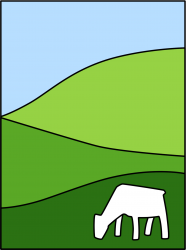Accounting for Livestock – Part 3 Valuation
By David Russell, Issue 4, Autumn 2007
New Zealand livestock valuation tax law had its first major revamp back in 1986. That was when the Herd Scheme valuation system was introduced, and along with it came the Trading Stock Scheme.
Before 1986 we used standard values that had originally been introduced way back in 1929. Standard values allowed farmers to use unchanging values year after year.
Typically, the standard value for sheep was $6, for dairy cows $70 was a common standard value, and for weaners/calves/rising one year dairy cattle the standard value was about $15. Many farmers, especially those who had been in business for a long period of years, had very low values. I can recall one farmer client had standard values of (£12) $24 for his adult dairy cattle and (£2) $4 for the weaner heifers.
The use of standard values eventually created huge distortions in some aspects of the farming industry – in particular, the exotic cattle boom in the early 1970's and the two deer boom and bust cycles in the late 1970's and the mid 1980's.
City Investors
Some farmers and lots of city based investors were paying outrageous amounts for livestock and then writing them down to low standard values.
The difference between the purchase cost and the standard value was tax deductible and if this could be offset against other income, a huge tax benefit ensued.
For example, a businessman could pay $8,000/head for red deer hinds and then write them down to a standard value of $200. The $7,800 write down, against a tax rate of 66%, meant that Government was effectively funding $5,184 of the cost of each animal by way of a tax refund to the investor.
Scared to Retire or Die
There were also problems for steady and sensible farmers when it came time for them to quit farming and retire. Back in the early 1980's dairy herds were selling for about $330/cow. If the standard value was (say) $60/cow someone selling up was exposed to tax on the difference between the tax value (standard value) and the selling price.
150 cows at $270 taxable sale profit at a 66% tax rate generated a tax bill of $26,730 on the herd. That sounds like a modest amount of tax by today's standards, but at the time it was an incomprehensible sum. The whole herd would have sold for $49,500; the taxman then stepped in and took $26,730. Lots of farmers were literally too scared to retire or die.
The introduction of the Herd Scheme in 1986-87 changed all of that. Initially, the Herd Scheme was limited to mature breeding cattle only but the system was further modified (quite significantly) in 1992-93. The Herd Scheme was extended to cover all classes of specified livestock; the Trading Stock Scheme was abandoned; a new national standard cost method was introduced; and some other cost based or value based methods were revamped into something workable.
As we came through those two transitions (in 1986-87 and 1992-93) there were some tax free revaluation options and some income spreading options, both of which eased the tax cost of the changes.
Tax Bills
The use of the Herd Scheme has more or less eliminated any serious tax bill at the time a farmer sells up or dies. Theoretically, the sale value when they quit farming should match the tax book value. Herd Scheme values are, after all, supposed to represent current national average market values.
The use of Herd Scheme values also (generally) means that there is no major tax benefit at the time of buying in additional livestock. If you expand the size of your herd by buying in an additional 20 cows at $1,200 head and then value them under the Herd Scheme ($1,187/head for Friesian cows in 2006), the whole transaction is virtually tax neutral.
So, is the Herd Scheme the answer to everything? Answer ~ could be, may be, it depends. More about that next issue…
